| Back to Back Issues Page |
 |
|
Bangkok Travelbug June 12 Exploring Samut Songkhram May 30, 2012 |
| Hello
Samut Songkhram Samut Songkhram (samut – sea or ocean, songkhram – war) is a relatively small province with only three districts; Amphur Samut Songkhram (city district), Amphur (district) Amphawa and Amphur Bang Khonthi. The Mae Klong River flows through the province from north to south. This river is actually a continuation of the River Kwai from Kanchanaburi to the north which goes through to Ratchaburi, on to Samut Songkhram and the Gulf of Thailand. Speak of Samut Songkhram and a number of things come to mind. Firstly it’s the Amphawa floating market and the fireflies in the area. Then there’s the Mae Klong line which terminates here. This, if you remember, is the quaint railway line from Bangkok – Samut Sakhon – Samut Songkhram which passes closely through the markets. A lesser known fact is that the famous Siamese twins, Chang and Eng who achieved world-renown, were born here in 1811. Samut Songkhram has its place in military history as well. After the fall of Ayutthaya in 1767, King Taksin regrouped his forces in Chanthaburi to the east. Later he set up a military camp in Bang Kung on the banks of the Mae Klong and defeated the Burmese in a major battle in the area. Being by the sea, Samut Songkhram is famous for its seafood. Its fertile soil produces a variety of vegetables and fruits. So our first stop is a lychee orchard for which Samut Songkhram is famous. Table of contents Visiting a lychee orchard I was surprised to learn that the lychee trees have been in Thailand for more than 100 years! The first lychee trees date back to 1854 in the reign of King Rama IV. The trees arrived with the early wave of Chinese immigrants who settled in various parts of Thailand. 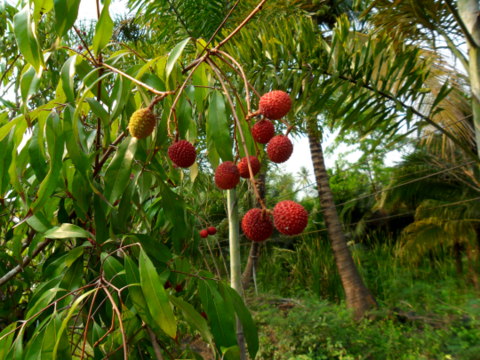
Lychee tree in Samut Songkhram Lychees (linchi in Thai) can be found in Chiang Mai in the north, Kanchanaburi in the north-west, Chanthaburi in the east and of course Samut Songakhram. Lychees bear fruits annually and at different times of the year depending on the region. Each region also has its special strain of lychee fruit. The fertile soil and climate of Samut Songkhram favours the cultivation of a number of fruits and vegetables among them, the lychee and pomelo. The day of my visit to the province coincided with the first day of the Fruit Festival in Samut Songkhram (31 March – 9 April 2012). We were lucky as a friend from Samut Songkhram was kind enough to take us to a relative’s lychee orchard to watch the harvesting and sorting of the fruits for the market. The lychee orchard is located in Tambon (sub-district) Bang Khae, Amphur (district) Amphawa that’s due west of Samut Songkhram city. The road through Bang Khae was lined with trees laden with the dark red lychee fruits. 
On the way to the lychee orchard The trees at the orchard were heavy with lychees. We could just reach out and pluck them. 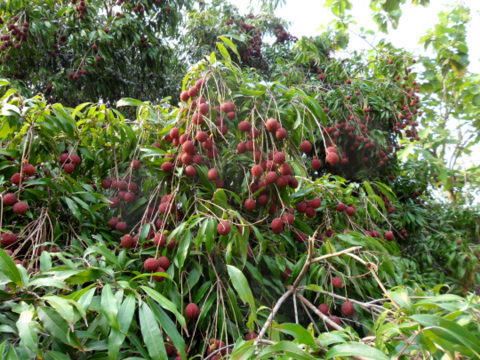
At the lychee orchard There are irrigation ditches criss-crossing the orchard with pipes and sprinklers to water the trees. We had to walk across several concrete slabs or planks to cross the ditches. 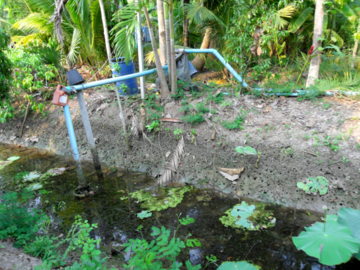
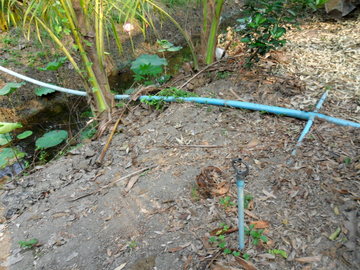
A group would pluck the lychees and take them in wheelbarrows to a central sorting area. When we arrived there was a group of people sorting the harvested lychees, weighing them, tying them up and bagging them for sale in the market. 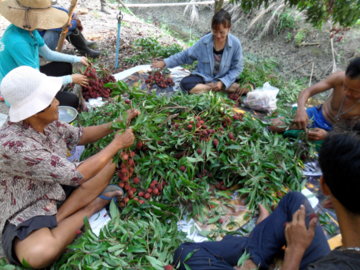

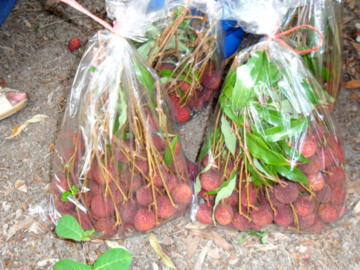
I was lucky enough to get a huge bunch of these lychees to take home. Table of contents Khai Bang Kung Khai Bang Kung or Bang Kung Camp in Amphur Bang Khonthi used to be a military camp. In the reign of King Taksin a camp was established here on the banks of the Mae Klong to block a Burmese from Kanchanaburi in the north-west, a traditional Burmese invasion route. The Burmese invasion eventually came and a major battle was fought near here in which the Siamese were victorious. 
Monument to King Taksin 
Statues of men in unarmed combat on the grounds The camp is no longer here today. All that remains are a building and monument dedicated to King Taksin, some stone statues of men engaged in unarmed combat and this very unusual building. It’s a rectangular building that’s a shrine with a huge Buddha image. The front of the building is covered by trees roots and creepers. 
The entrance The building is buttressed by four trees at each corner; Pho, Sai, Krang, Krai, seemingly holding the building in place. 
Pho tree 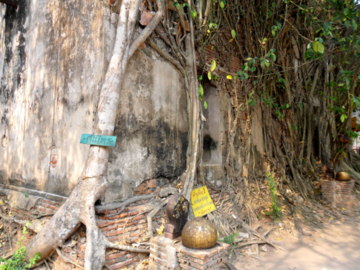

Krang tree 
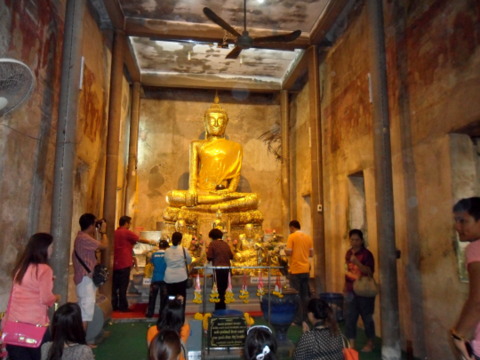
Inside the building Table of contents The Nativity of Our Lady Cathedral You wouldn’t expect to find an old and beautiful Catholic cathedral in Gothic architecture all the way out here in Samut Songkhram. This cathedral on the banks of the Mae Klong is dedicated to the Nativity of Our Lady. The Nativity of Our Lady refers to the birth of the Virgin Mary. There was a childless and pious couple Joachim and Anna who prayed very hard for a child. One day an angle appeared before Anna and told her, "You shall conceive and bring forth, and your progeny shall be spoken of in all the world". Anna promised to dedicate the child to God and when the child was born she was named Mary. 
How did this cathedral end up here? In 1845 Father Albrand, a Roman Catholic priest from the Singapore who was proficient in the Chinese language was assigned to the Holy Rosary Church, Talat Noi, Bangkok. While on missionary work in the Mae Klong valley, Father Albrand came across eight Catholic Chinese families from the Holy Rosary Church who had settled in the area. Within two years the number of Catholics grew to 200 and a wooden church was built for the congregation. In 1850 Father Marin acquired a piece of land by the Bang Nok Khuek canal which linked the Mae Klong and Tha Chin Rivers. The land was dedicated to the Nativity of Our Lady. It was only in 1890 that Father Paolo Salmone started work on a concrete church. Funds were raised from Catholic churches from Bangkok to Paris and Rome. The church was completed in 1896. 
Artist’s impression of the cathedral The Nativity of Our Lady Cathedral had a grand opening on 11 February 1896. 
Nativity of Our Lady Cathedral 
Inside the cathedral The cathedral was renovated in 1994 in preparation for the centenary. It’s a beautiful cathedral with majestic architecture and scenic surroundings on the banks of the Mae Khlong. 
Entrance to the cathedral 
Pier by the Mae Klong River 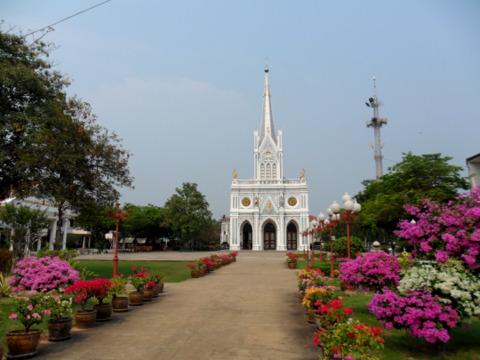
View of the cathedral and garden from the Mae Klong River 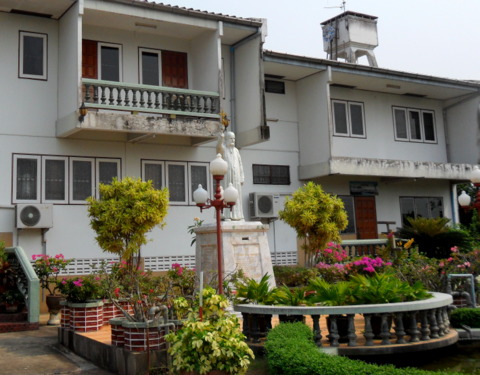
Statue of Father Paolo Salmone in front of the priests’ quarters The stained glass windows up on the walls are another attractive feature of the Nativity of Our Lady Cathedral. These windows which were made in France depict the life of the Virgin Mary. As the stained glass windows are high up on the walls, I am unable to take photos of them. Here are some shots of the windows taken off the brochure from the cathedral. 
The birth of the Virgin Mary 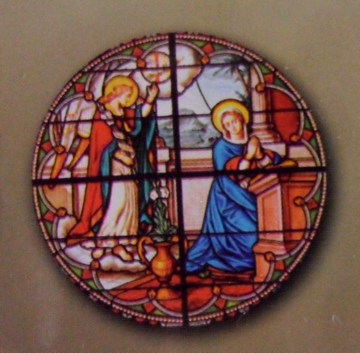
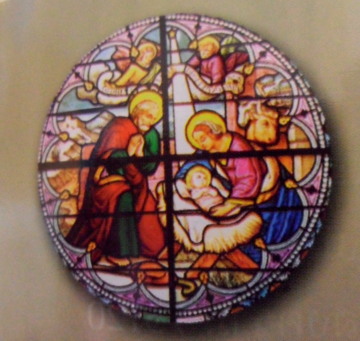
The Virgin Mary gives birth to the child Jesus 

The Virgin Mary being crowned in Heaven For other Catholic Churches in Thailand Bangkok Assumption Cathedral Holy Rosary Church Immaculate Conception Church Santa Cruz Church St Francis Xavier Church Chanthaburi Cathedral of the Immaculate Conception Nakhon Phanom St Anna’s Church Samut Sakhon St Anna Church We have just visited three very different places in Samut Songkhram, with diverse cultures blending in harmoniously. Table of contents Map of Samut Songkhram View Exploring Samut Songkhram in a larger map Getting to Samut Songkhram By car From Bangkok cross over to the Thonburi bank and take Rama II Road which continues on to Highway 35 all the way to Samut Songkhram. Mae Klong line If you like a train ride, you can take the Mae Klong line from Wong Wian Yian in Bangkok to Samut Songkhram. Here are some of the sights to expect on this train ride. It’s a very different view from a car ride. Table of contents My thanks My thanks to

Khun Wanpen and her granddaughter Pimwipa 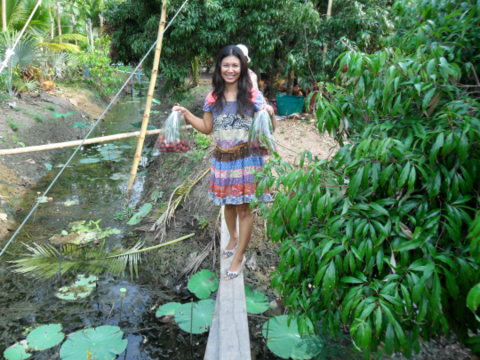
Jantana walking the plank, try doing this in two-inch platform shoes! Where to stay – hotels in Samut Songkhram Samut Songkhram is just a day trip from Bangkok. However if you like to stay over to enjoy the atmosphere of the place, here are some hotels. Ban Platubtim Resort Ban Imoun Hotel Baan Amphawa Resort & Spa Baan Suan Nuan Ta Baan Tai Had Resort Baanpiangtawan Banbauntoum Ta Ngok Chababaancham Resort Jaroenrat Resort Khetwarin Resort Kulnatee Resort The Legend Panviman Amphawa Riverside Resort Relax Smile Resort Ruenmalai Homestay Ruen Thai Amphawa Resort Ruenthai Bangkung Resort Serenehome @ Samutsongkhram Table of contents Next month Amphawa and Bang Noi – two contrasting floating markets 

If you enjoyed reading this e-zine, please forward it to a friend. If you received this from a friend and found it interesting, please subscribe at Bangkok Travelbug. What you think of the Bangkok Travelbug? We love to hear from you What other subscribers have said Till next month then. Eric Lim Find us on Facebook Stay updated with what’s new at Tour Bangkok Legacies. Copy the link below and paste it into your Google Reader, NetNewsWire or your favorite feed reader. https://www.tour-bangkok-legacies.com/tour-Bangkok-legacies.xml If you use My Yahoo! or My MSN, head over to my home page and click on the button for your favourite Web-based feed reader. Visit our home page at Tour Bangkok Legacies. Copyright@2008-2009 Tour Bangkok Legacies All rights reserved |
| Back to Back Issues Page |